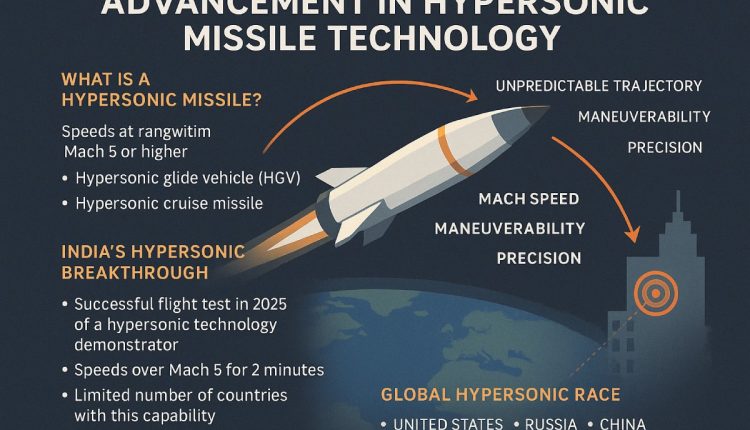India’s Supersonic Rise in Strategic Defense
India has made a historic stride in defense science with the successful development and testing of hypersonic missile technology. As of 2025, this places India among a select group of nations—including the US, Russia, and China—that are capable of designing and deploying weapons that travel at speeds greater than Mach 5 (five times the speed of sound).
This breakthrough is not just a technological marvel—it’s a strategic game-changer that transforms how India is perceived in the global security ecosystem.
What is a Hypersonic Missile?
A hypersonic missile is a weapon that can travel at speeds exceeding 6,000 km/h (Mach 5), and is either:
-
A Hypersonic Glide Vehicle (HGV), which is launched from a conventional rocket before gliding to its target, or
-
A Hypersonic Cruise Missile, powered by advanced air-breathing engines like scramjets.
These missiles are extremely difficult to intercept using current missile defense systems due to their:
-
High velocity
-
Unpredictable trajectories
-
Maneuverability during flight
India’s Hypersonic Journey: DRDO’s Crucial Role
India’s defense research has long been spearheaded by the Defence Research and Development Organisation (DRDO). Over the past decade, DRDO has accelerated its hypersonic program with the following milestones:
-
HSTDV (Hypersonic Technology Demonstrator Vehicle):
First flight-tested in 2020, marking India’s foray into scramjet propulsion systems. -
2024-2025 Advancements:
Recent tests have reportedly included improved prototypes of hypersonic glide vehicles and enhanced tracking systems that successfully demonstrated sustained hypersonic flight for over 2 minutes. -
Indigenous Components:
India’s hypersonic program has been developed with significant indigenous innovation, reducing reliance on foreign tech.
Strategic Implications of Hypersonic Missiles
1. Enhanced Deterrence Capability
Hypersonic weapons significantly boost India’s deterrence against regional threats. Their speed and precision allow for both first-strike and counter-strike superiority.
2. Overcoming Missile Defense Systems
Most conventional anti-missile systems cannot track or intercept hypersonic weapons effectively, making them nearly impossible to defend against.
3. Precision Targeting
These weapons can be programmed to target high-value assets deep inside enemy territory with unparalleled accuracyand speed.
4. Strategic Autonomy
By developing this tech indigenously, India affirms its position as a self-reliant and advanced military power, aligned with its Make in India and Atmanirbhar Bharat visions.
India Among Global Powers
As of 2025, only a handful of countries possess verified hypersonic weapon capabilities:
-
Russia: Avangard (HGV), Zircon (Cruise)
-
China: DF-ZF HGV
-
USA: ARRW and Hypersonic Attack Cruise Missile in development
-
India: HSTDV and classified missile prototypes under development
India’s entry into this elite group has prompted attention from global defense alliances and think tanks. The successful tests underscore India’s readiness to shift its defense doctrine toward cutting-edge future warfare.
What Makes Hypersonic Missiles So Revolutionary?
-
Speed: Mach 5 to Mach 10 range (can cross 1,000 km in just 6–8 minutes)
-
Trajectory: Not fixed like ballistic missiles; harder to predict or intercept
-
Impact Energy: Even without explosives, the kinetic energy can destroy hardened targets
-
Multi-role Capability: Usable for conventional strikes or as a delivery system for nuclear payloads
The Road Ahead: What to Expect
India is now focused on:
-
Operationalizing hypersonic systems in the Indian Armed Forces within the next 3–5 years.
-
Integrating AI-powered targeting for more precision
-
Expanding test ranges to simulate real-world military scenarios
-
Developing counter-hypersonic defense systems to maintain balance
The race is not only about offense—it’s about preparing a multi-layered defense grid that includes early detection, tracking, and response.
Final Thoughts: India’s Technological Renaissance
India’s advancement in hypersonic missile technology is a defining moment in 21st-century defense strategy. With homegrown innovation, smart partnerships, and unwavering focus, India has transitioned from a regional power to a global player in future warfare capabilities.
The success of these projects will not only ensure better strategic deterrence but will also open new doors in space exploration, aerospace propulsion, and global defense collaboration.
In short—India is not just catching up; it’s setting the pace.


Comments are closed.